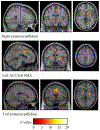Altered amygdala subregion-related circuits in treatment-naïve post-traumatic stress disorder comorbid with major depressive disorder
- PMID: 31488341
- PMCID: PMC7434633
- DOI: 10.1016/j.euroneuro.2019.07.238
Altered amygdala subregion-related circuits in treatment-naïve post-traumatic stress disorder comorbid with major depressive disorder
Abstract
Individuals with both post-traumatic stress disorder and major depressive disorder (PTSD+MDD) often show greater social and occupational impairment and poorer treatment response than individuals with PTSD alone. Increasing evidence reveals that the amygdala, a brain region implicated in the pathophysiology of both of these conditions, is a complex of structurally and functionally heterogeneous nuclei. Quantifying the functional connectivity of two key amygdala subregions, the basolateral (BLA) and centromedial (CMA), in PTSD+MDD and PTSD-alone could advance our understanding of the neurocircuitry of these conditions. 18 patients with PTSD+MDD, 28 with PTSD-alone, and 50 trauma exposed healthy controls (TEHC), all from a cohort who survived the same large earthquake in China, underwent resting-state functional magnetic resonance imaging. Bilateral BLA and CMA functional connectivity (FC) maps were created using a seed-based approach for each participant. The analysis of covariance of FC was used to determine between-group differences. A significant interaction between amygdala subregion and diagnostic group suggested that differences in connectivity patterns between the two seeds were mediated by diagnosis. Post-hoc analyses revealed that PTSD+MDD patients showed weaker connectivity between right BLA and (a) left anterior cingulate cortex/supplementary motor area, and (b) bilateral putamen/pallidum, compared with PTSD-alone patients. Higher CMA connectivities left ACC/SMA were also observed in PTSD+MDD compared with PTSD-alone. An inverse relationship between the connectivity of right BLA with right putamen/pallidum and MDD symptoms was found in PTSD+MDD. These findings indicate a relationship between the neural pathophysiology of PTSD+MDD compared with PTSD-alone and TEHC and may inform future clinical interventions.
Keywords: Amygdala; Fear processing; Major depressive disorder; Post-traumatic stress disorder; Resting-state functional connectivity.
Copyright © 2019. Published by Elsevier B.V.
Conflict of interest statement
Declaration of Competing Interest
Drs. Mann receives royalties for commercial use of the Columbia-Suicide Severity Rating Scale (C-SSRS) from the Research Foundation for Mental Hygiene. Other authors have no conflicts of interest to report.
Figures




References
-
- Amunts K, Kedo O, Kindler M, Pieperhoff P, Mohlberg H, Shah N, Habel U, Schneider F, Zilles K, 2005. Cytoarchi-tectonic mapping of the human amygdala, hippocampal region and entorhinal cortex: intersubject variability and probability maps. Anat. Embryol 210, 343–352. - PubMed
-
- Association, A.P. , 2013. Diagnostic and Statistical Manual of Mental Disorders (DSM-5®). American Psychiatric Publishing.
Publication types
MeSH terms
Grants and funding
LinkOut - more resources
Full Text Sources
Medical

